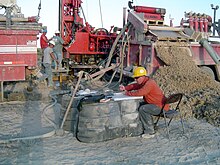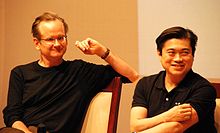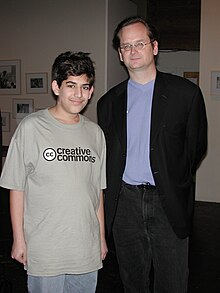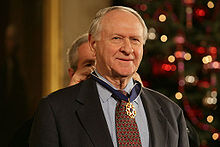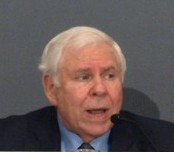Hydrocarbon exploration (or oil and gas exploration) is the search by petroleum geologists and geophysicists for deposits of hydrocarbons, particularly petroleum and natural gas, in the Earth using petroleum geology.
Exploration methods
Visible surface features such as oil seeps, natural gas seeps, pockmarks
(underwater craters caused by escaping gas) provide basic evidence of
hydrocarbon generation (be it shallow or deep in the Earth). However,
most exploration depends on highly sophisticated technology to detect
and determine the extent of these deposits using exploration geophysics. Areas thought to contain hydrocarbons are initially subjected to a gravity survey, magnetic survey, passive seismic or regional seismic reflection surveys to detect large-scale features of the sub-surface geology. Features of interest (known as leads)
are subjected to more detailed seismic surveys which work on the
principle of the time it takes for reflected sound waves to travel
through matter (rock) of varying densities and using the process of depth conversion
to create a profile of the substructure. Finally, when a prospect has
been identified and evaluated and passes the oil company's selection
criteria, an exploration well
is drilled in an attempt to conclusively determine the presence or
absence of oil or gas.Offshore the risk can be reduced by using
electromagnetic methods.
Oil exploration is an expensive, high-risk operation. Offshore
and remote area exploration is generally only undertaken by very large
corporations or national governments. Typical shallow shelf oil wells
(e.g. North Sea)
cost US$10 – 30 million, while deep water wells can cost up to US$100
million plus. Hundreds of smaller companies search for onshore
hydrocarbon deposits worldwide, with some wells costing as little as
US$100,000.
Elements of a petroleum prospect
Mud log in process, a common way to study the rock types when drilling oil wells.
A prospect is a potential trap
which geologists believe may contain hydrocarbons. A significant amount
of geological, structural and seismic investigation must first be
completed to redefine the potential hydrocarbon drill location from a lead
to a prospect. Four geological factors have to be present for a
prospect to work and if any of them fail neither oil nor gas will be
present.
- Source rock
- When organic-rich rock such as oil shale or coal is subjected to high pressure and temperature over an extended period of time, hydrocarbons form.
- Migration
- The hydrocarbons are expelled from source rock by three density-related mechanisms: the newly matured hydrocarbons are less dense than their precursors, which causes over-pressure; the hydrocarbons are lighter, and so migrate upwards due to buoyancy, and the fluids expand as further burial causes increased heating. Most hydrocarbons migrate to the surface as oil seeps, but some will get trapped.
- Reservoir
- The hydrocarbons are contained in a reservoir rock. This is commonly a porous sandstone or limestone. The oil collects in the pores within the rock although open fractures within non-porous rocks (e.g. fractured granite) may also store hydrocarbons. The reservoir must also be permeable so that the hydrocarbons will flow to surface during production.
- Trap
- The hydrocarbons are buoyant and have to be trapped within a structural (e.g. Anticline, fault block) or stratigraphic trap. The hydrocarbon trap has to be covered by an impermeable rock known as a seal or cap-rock in order to prevent hydrocarbons escaping to the surface
Exploration risk
Hydrocarbon exploration is a high risk investment and risk assessment is paramount for successful project portfolio management.
Exploration risk is a difficult concept and is usually defined by
assigning confidence to the presence of the imperative geological
factors, as discussed above. This confidence is based on data and/or
models and is usually mapped on Common Risk Segment Maps (CRS Maps).
High confidence in the presence of imperative geological factors is
usually coloured green and low confidence coloured red.
Therefore, these maps are also called Traffic Light Maps, while the
full procedure is often referred to as Play Fairway Analysis.
The aim of such procedures is to force the geologist to objectively
assess all different geological factors. Furthermore, it results in
simple maps that can be understood by non-geologists and managers to
base exploration decisions on.
Terms used in petroleum evaluation
- Bright spot
- On a seismic section, coda that have high amplitudes due to a formation containing hydrocarbons.
- Chance of success
- An estimate of the chance of all the elements (see above) within a prospect working, described as a probability.
- Dry hole
- A boring that does not contain commercial hydrocarbons.
- Flat spot
- Possibly an oil-water, gas-water or gas-oil contact on a seismic section; flat due to gravity.
- Full Waveform Inversion
- A supercomputer technique recently use in conjunction with seismic sensors to explore for petroleum deposits offshore.
- Hydrocarbon in place
- Amount of hydrocarbon likely to be contained in the prospect. This is calculated using the volumetric equation - GRV x N/G x Porosity x Sh / FVF
-
- Gross rock volume (GRV)
- Amount of rock in the trap above the hydrocarbon water contact
- Net sand
- Part of GRV that has the lithological capacity for being a productive zone; i.e. less shale contaminations.
- Net reserve
- Part of net sand that has the minimum reservoir qualities; i.e. minimum porosity and permeability values.
- Net/gross ratio (N/G)
- Proportion of the GRV formed by the reservoir rock (range is 0 to 1)
- Porosity
- Percentage of the net reservoir rock occupied by pores (typically 5-35%)
- Hydrocarbon saturation (Sh)
- Some of the pore space is filled with water - this must be discounted
- Formation volume factor (FVF)
- Oil shrinks and gas expands when brought to the surface. The FVF converts volumes at reservoir conditions (high pressure and high temperature) to storage and sale conditions
- Lead
- Potential accumulation is currently poorly defined and requires more data acquisition and/or evaluation in order to be classified as a prospect.
- Play
- An area in which hydrocarbon accumulations or prospects of a given type occur. For example, the shale gas plays in North America include the Barnett, Eagle Ford, Fayetteville, Haynesville, Marcellus, and Woodford, among many others.
- Prospect
- A lead which has been more fully evaluated.
- Recoverable hydrocarbons
- Amount of hydrocarbon likely to be recovered during production. This is typically 10-50% in an oil field and 50-80% in a gas field.
Licensing
Petroleum
resources are typically owned by the government of the host country. In
the United States, most onshore (land) oil and gas rights (OGM) are
owned by private individuals, in which case oil companies must negotiate
terms for a lease of these rights with the individual who owns the OGM.
Sometimes this is not the same person who owns the land surface. In
most nations the government issues licences to explore, develop and
produce its oil and gas resources, which are typically administered by
the oil ministry. There are several different types of licence. Oil
companies often operate in joint ventures to spread the risk; one of the
companies in the partnership is designated the operator who actually
supervises the work.
- Tax and Royalty
- Companies would pay a royalty on any oil produced, together with a profits tax (which can have expenditure offset against it). In some cases there are also various bonuses and ground rents (license fees) payable to the government - for example a signature bonus payable at the start of the licence. Licences are awarded in competitive bid rounds on the basis of either the size of the work programme (number of wells, seismic etc.) or size of the signature bonus.
- Production Sharing contract (PSA)
- A PSA is more complex than a Tax/Royalty system - The companies bid on the percentage of the production that the host government receives (this may be variable with the oil price), There is often also participation by the Government owned National Oil Company (NOC). There are also various bonuses to be paid. Development expenditure is offset against production revenue.
- Service contract
- This is when an oil company acts as a contractor for the host government, being paid to produce the hydrocarbons.
Reserves and resources
Resources
are hydrocarbons which may or may not be produced in the future. A
resource number may be assigned to an undrilled prospect or an
unappraised discovery. Appraisal by drilling additional delineation
wells or acquiring extra seismic data will confirm the size of the field
and lead to project sanction. At this point the relevant government
body gives the oil company a production licence which enables the field
to be developed. This is also the point at which oil reserves and gas reserves can be formally booked.
Oil and gas reserves
Oil
and gas reserves are defined as volumes that will be commercially
recovered in the future. Reserves are separated into three categories:
proved, probable, and possible. To be included in any reserves category,
all commercial aspects must have been addressed, which includes
government consent. Technical issues alone separate proved from unproved
categories. All reserve estimates involve some degree of uncertainty.
- Proved reserves are the highest valued category. Proved reserves have a "reasonable certainty" of being recovered, which means a high degree of confidence that the volumes will be recovered. Some industry specialists refer to this as P90, i.e., having a 90% certainty of being produced. The SEC provides a more detailed definition:
Proved oil and gas reserves are those quantities of oil and gas,
which, by analysis of geoscience and engineering data, can be estimated
with reasonable certainty to be economically producible—from a given
date forward, from known reservoirs, and under existing economic
conditions, operating methods, and government regulations—prior to the
time at which contracts providing the right to operate expire, unless
evidence indicates that renewal is reasonably certain, regardless of
whether deterministic or probabilistic methods are used for the
estimation. The project to extract the hydrocarbons must have commenced
or the operator must be reasonably certain that it will commence the
project within a reasonable time.
- Probable reserves are volumes defined as "less likely to be recovered than proved, but more certain to be recovered than Possible Reserves". Some industry specialists refer to this as P50, i.e., having a 50% certainty of being produced.
- Possible reserves are reserves which analysis of geological and engineering data suggests are less likely to be recoverable than probable reserves. Some industry specialists refer to this as P10, i.e., having a 10% certainty of being produced.
The term 1P is frequently used to denote proved reserves; 2P is the
sum of proved and probable reserves; and 3P the sum of proved, probable,
and possible reserves. The best estimate of recovery from committed
projects is generally considered to be the 2P sum of proved and probable
reserves. Note that these volumes only refer to currently justified
projects or those projects already in development.
Reserve booking
Oil and gas reserves are the main asset of an oil company. Booking is the process by which they are added to the balance sheet.
In the United States, booking is done according to a set of rules developed by the Society of Petroleum Engineers (SPE). The reserves of any company listed on the New York Stock Exchange have to be stated to the U.S. Securities and Exchange Commission. Reported reserves may be audited by outside geologists, although this is not a legal requirement.
In Russia, companies report their reserves to the State Commission on Mineral Reserves (GKZ).

